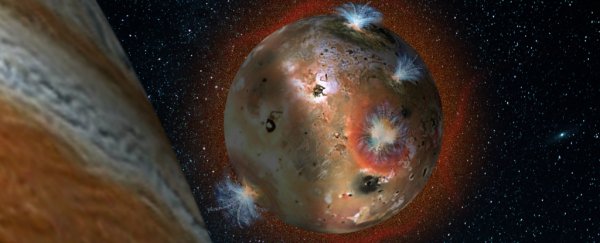Jupiter's frozen moon Io is a pretty bleak place, with a toxic atmosphere and the most active volcanoes of any known body in the Solar System.
But it's somehow managed to get even more miserable, because scientists just watched its atmosphere collapse - something that apparently happens every single day as Jupiter eclipses it.
Astronomers have long suspected that Io's already thin atmosphere deflates as the shadow of the gas giant passes over it daily, but no one had ever been able to see this happening until now.
"This research is the first time scientists have observed this remarkable phenomenon directly, improving our understanding of this geologically active moon," said lead researcher Constantine Tsang from the Southwest Research Institute in Colorado.
The study shows that for 2 hours every day, Jupiter eclipses the moon with its giant shadow, causing the temperature to plummet and Io's sulphur dioxide-rich atmosphere to freeze and collapse to the surface.
When the planet moves out of Jupiter's shadow, the Sun gradually heats Io's surface temperature up from about –270 degrees Fahrenheit (–168 degrees Celsius) to –235 degrees Fahrenheit (–148 degrees Celsius), and the sulphur dioxide returns to the atmosphere as gas.
But then the whole cycle repeats again the next day, and seeing as a day on Io lasts around 1.7 Earth days, the atmosphere is deflating and reflating all the time.
"This confirms that Io's atmosphere is in a constant state of collapse and repair, and shows that a large fraction of the atmosphere is supported by sublimation of SO2 [sulphur dioxide] ice," said one of the team, John Spencer. "We've long suspected this, but can finally watch it happen."
The team was able to figure this out using the Gemini North telescope in Hawaii, in addition to a long-range spectrograph, which was capable of monitoring the composition of the moon's atmosphere.
Using this combination to measure the electromagnetic signatures coming off Io in real-time, the team could show that the sulphur dioxide content drops off daily during Jupiter's eclipse.
The findings have been published in the Journal of Geophysical Research.
Perhaps the most exciting part of all is that most of Jupiter's 67 known moons - and the punishment the gas giant unleashes on them - remain a mystery to us.
But now that we have our own probe, Juno, in orbit around the planet, we'll hopefully get some more insight into the strange behaviour occurring in the neighbourhood.
It's still early days for the mission, but we've already heard creepy AF sounds coming from around Jupiter, and have been sent this visible-light photo of the gas giant with Io, Europa, and Ganymede:
 NASA
NASA
We can't wait for more strangeness. Stay tuned.
